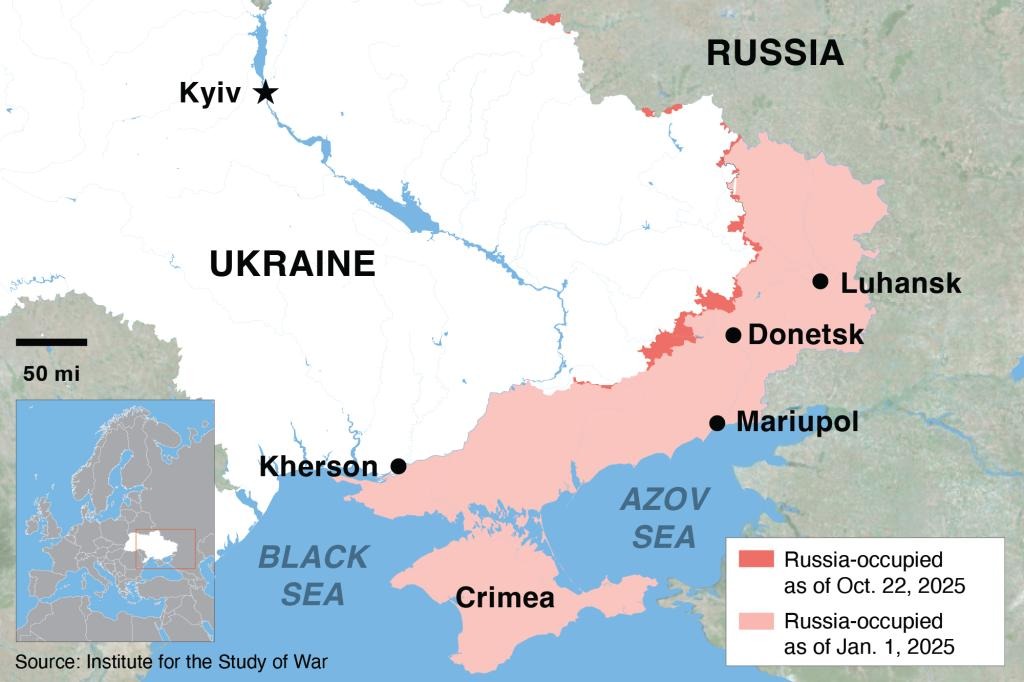ISW: Putin and Gerasimov keep boasting of sweeping wins in Ukraine—but even Russian milbloggers call them fiction

Russian leaders keep claiming non-existent major battlefield victories in Ukraine, yet these boasts are being publicly dismissed even by pro-war Russian milbloggers, who describe the situation on the ground as chaotic and accuse the military leadership of inflating results, the Institute for the Study of War (ISW) said on 26 October.
Putin and Gerasimov outline sweeping operations
Russian President Vladimir Putin and Chief of the General Staff Army General Valery Gerasimov have continued to issue claims of major battlefield victories while reaffirming the Kremlin’s intent to capture all of Luhansk, Donetsk, Zaporizhzhia, and Kherson oblasts.
ISW says Putin held a meeting on 26 October with Gerasimov and commanders of Russia’s groupings of forces. The event drew attention because Putin appeared in military uniform—only the third such appearance since the start of the full-scale invasion and just weeks after the previous one on 16 September. During his report to Putin, Gerasimov said Russian forces were continuing operations to seize all territory within the four illegally annexed Ukrainian oblasts.
He further claimed that Russian forces from the Western Grouping had ostensibly encircled Kupiansk in Kharkiv Oblast. According to him, detachments from the 68th Motorized Rifle Division crossed the Oskil River south of the town and, together with units from the 47th Tank Division and 27th Motorized Rifle Brigade of the 1st Guards Tank Army, had allegedly cut off Ukrainian troops on the eastern bank. Gerasimov stated that 18 Ukrainian battalions were trapped in Kupiansk.
He also declared Russian progress in the northeast and east of Ukraine, including the seizure of more than 70% of Vovchansk, completion of fighting in Yampil, and the capture of Dronivka and Pleshchiivka. Gerasimov said Russian troops continued urban fighting in Siversk and Kostiantynivka.

NYP: Russia tells the world it’s winning — actual military performance paints a different picture
Russian milbloggers openly challenge the official version
Several Russian milbloggers said the claims of encirclements in Pokrovsk and Kupiansk were false. One wrote that a wide corridor still separates Russian groups west and north of Pokrovsk, while another pointed out that Russian fire control over Ukrainian supply lines does not mean a full encirclement.
Others highlighted the porous nature of the front and said that Russian forces often declare towns captured while Ukrainian troops still hold positions there. One described the situation in Pokrovsk and Kupiansk as “100% chaos.” Another blogger said Gerasimov was “getting ahead of himself again,” predicting that the general expected reality to eventually align with his optimistic reports. That same source argued that the exaggerated claims were meant to influence US President Donald Trump by giving him the impression that Ukrainian forces faced collapse.
"Gerasimov similarly presented exaggerated territorial claims in late August 2025, including about Kupiansk, that Russian milbloggers heavily criticized," ISW wrote.
Read also
-
Ukraine’s 82nd Brigade liberated Sukhetske in Donetsk Oblast — 44 Russians killed, 9 captured in fierce clash, the military says (video)
-
Mini Bilohorivka moment as six Russian vehicles sink during failed river push in Donetsk Oblast today (video)
-
Ukrainian paratroopers liberate Donetsk village in daring raid, capturing 50 Russian troops and rescuing trapped civilians
